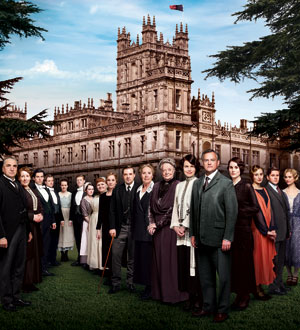November 2013 | view this story as a .pdf
There’s a reason it’s called New England.
By Brad Emerson
 It has been 236 years since Maine ceased to be part of England, excepting the brief-occupation War of 1812. Despite the loss of a monarch, Maine continued to look to England, more than any other country, for its architecture, language, and customs, and with another season of Downton Abbey imminent, we will once again be besotted with the life of an English country estate.
It has been 236 years since Maine ceased to be part of England, excepting the brief-occupation War of 1812. Despite the loss of a monarch, Maine continued to look to England, more than any other country, for its architecture, language, and customs, and with another season of Downton Abbey imminent, we will once again be besotted with the life of an English country estate.
The landed ancestral country estate is very much a European model, its roots in Medieval times, brought to its full ideal in 18th century England, with a glamorous last gasp in Edwardian times before the first World War. With its vast tracts of open lands, Maine attracted speculators and investors, several of whom attempted to establish country estates on the English model as symbols of their power and status, and to attract settlers to the wilderness.
Here are three versions of the English manor ideal, as transported to Maine–one the residence of a prominent attorney whose private hours were spent in enjoyment of the past; one a true English-style family estate; and one the residence of a modern industrialist on vacation from the business world.
Walter Davis Mansion
155 Western Promenade
The Town House
Walter Davis, son of a prominent Portland family, was a graduate of Yale and of Harvard Law School. Very much a modern man in his professional life–as an attorney he was active in the affairs of banks and railroads in the state–he was, in his private life, a dedicated historian. For many years he was president of the Maine Historical Society, and like many of his generation and class, Davis was a dedicated Anglophile, visiting England regularly. His Cape Elizabeth summer house was a pure adaptation of a 16th-century Cotswold manor house. For his city house on Portland’s Western Promenade, he chose to visit the 18th century, evoking the England of Johnson and Boswell, by duplicating an English manor in the early 18th century style. For his architect, he chose William Lawrence Bottomley, a society architect noted for his sophisticated brick Georgian houses in Virginia and Long Island, in association with Leigh French, Jr., a New York architect-decorator best known today for his early books about Colonial interiors.
According to Maine State Historian Earle Shettleworth, Jr., who knew Davis, the model was a manor house that Davis had seen on a bicycle tour of England, likely the charming Stuart-style brick manor at Chipping Camden, whose design and composition were closely followed in the Davis house with a few differences–notably the balconet over the entrance, in the Portland house–as translated to a city lot. It was one of the last of the large houses built on the Western Promenade (1920), and its very proper Englishness added a new style note to the eclectic mix already present in the neighborhood. Inside, high paneled rooms; tall, deeply recessed windows; and Georgian chimneypieces made a reassuringly correct backdrop in which the Dowager Countess might feel at home, not surprising as Davis originally shared this house with his mother, who had formerly lived around the corner in the grand Edwardian mansion that John Calvin Stevens had designed for Walter Davis Sr. nearly four decades earlier.
Oaklands
Dresden Avenue, Gardiner
The Country Estate
Oaklands, the estate of the Gardiner family of Gardiner, Maine, is probably the truest example of English landed architecture in our ken.
Several early land speculators attempted to establish estates on the English model–notably General Henry Knox, who constructed a house in Thomaston with “a beauty, symmetry and magnificence” unequalled in the region, resplendent with an oval room like those made newly fashionable by the Adam brothers in England. John Black in Ellsworth, an Englishman sent by Baring Brothers Bank to work for the Binghams family of Philadelphia, later London, who owned 2,000,000 acres of Maine, created an admirable retreat in Ellsworth. But none could measure up to Oaklands, the estate of the Gardiner family of Gardiner, Maine.
Dr. Silvester Gardiner, a Rhode Island pharmacist who held the only European medical degree in the colonies, purchased nearly 100,000 acres of Maine at the headwaters of the Kennebec River, and there established a village.
Having pledged allegiance to the Crown during the Revolution, Gardiner removed to England after his lands were confiscated here. Fortunately for the Gardiner family, there was an error in the legal documents, and in 1787, they were able to reclaim their property. Gardiner’s son having died, the estate was offered to grandson Robert Hallowell, following the English tradition of primogeniture, provided he take the Gardiner name, which he did.
After his graduation from Harvard, Robert Hallowell Gardiner, now married to Delia Tudor, daughter of William Tudor, the Boston ‘Ice King,’ built the first Oaklands, a Georgian mansion with columned portico, where he lived in aristocratic splendor until 1833, when that house burned. Fortunately, the family portraits, including the great Copley rendering of Sylvester Gardiner, were saved by the servants. There was no question but that the family would rebuild, and Richard Upjohn, a young English architect who had emigrated to America four years before, eventually winding up in Boston, was hired. It was his major commission to date, in the modern gothic style, predating the works of Andrew Jackson Davis on the Hudson by nearly a decade. No expense was spared. As proof against fire, Upjohn made use of Hallowell granite from the family’s own quarries. A desire to reuse the earlier foundation placed certain restraints on the picturesque composition and plan.
Robert Hallowell Gardiner had already made an earlier foray into the new Gothic style, providing the funds for Christ Church in Gardiner in 1819, which was designed by his new English minister, Samuel Farmer Jarvis, who had been serving as rector in the Bloomingdale parish of New York. It was the third Gothic church in New England, the first Gothic-inspired building in Maine, and one of the earliest in the country in that style
The new Oaklands mansion (1836) was and is one of the wonders of Maine; writing in his American Notebooks in 1837, Nathaniel Hawthorne describes the house in breathless superlatives: “The new building was estimated, I believe, to cost about thirty thousand dollars; but twice as much has already been expended, and a great deal more will be required to complete it. It is certainly a splendid structure; the material, granite from the vicinity. At the angles, it has small, circular towers; the portal is lofty and imposing; relatively to the general style of domestic architecture in our country, it well deserves the name of castle or palace. Its situation, too, is fine, far retired from the public road, and attainable by a winding carriage drive, standing amid fertile fields, and with large trees in the vicinity. There is also a beautiful view from the mansion down the Kennebec.”
Surrounding the house was an English-style park in the tradition of Capability Brown and Humphrey Repton, the great English practioners of ‘naturalistic’ landscape. The park was laid out by a Gardiner son-in-law, Francis Richards.
Oaklands has maintained its dignity while being handed down through the generations. As befits a manor house, its scions have a long tradition of public service, including William Tudor Gardiner, governor of Maine, and Robert Gardiner, the former head of Maine Public Broadcasting. Today it remains private property, still owned by the Gardiner family, its remaining 800 acres still farmed. Passersby on the river road blink in amazement at this English engraving come to life.
Fairfields
28 Beach Avenue, Kennebunk
The Seaside Manor
Perhaps no style is as thoroughly associated with England as the half-timbered Tudor manor house. The motif was so seized upon by America’s newly minted plutocrats, lending age and gravitas to their surroundings, that satirist Osbert Lancaster coined the phrase ‘Stockbroker Tudor’ to describe the style. Most popular in country suburbs from Greenwich to Lake Forest, a few examples escaped up here to the grander Maine summer colonies, where their timbered gables blended surprisingly well with the seaside location.
One of the most notable of these Olde Englishe cottages was ‘Fairfields,’ the Kennebunk estate of William Rogers (1851-1946), an industrialist from Buffalo, New York–a leading figure in the iron trade that flourished there. For his architects, Rogers chose Green & Wicks, the leading architectural firm in Buffalo, who had previously renovated Rogers’s Buffalo mansion. Work
While hardly on the scale of an English country estate, the Rogers property was far larger than the suburban-sized lots that supported most summer cottages in the region, with 60 acres looking out to sea along the Kennbunk River, with an adjoining forest of 90 acres once owned by Sir William Pepperell, America’s only baronet.
The design of ‘Fairfields’ (1907) owes as much to the English Arts & Crafts movement as to 16th century England. It is a long, rambling structure arranged for maximum picturesque effect, the brick first floor contrasting with the stucco and half-timbering of the upper stories. The supporting structures included a gardener’s cottage, greenhouse, garage, stable, and boathouse, all in the same style, to house the staff and amenities required for the comfortable life led there. Within, the long entrance hall, with its paneling and antique English fireplace recalled the long galleries of Elizabethan manor houses, where the lords and ladies would take indoor promenades in bad weather.
The estate was purchased in 1936 by Col. William Neal Campbell, president of the Goodall Worsted Company in Sanford (makers of the once ubiquitous ‘Palm Beach’ suits). The Campbells and their daughters lived an attractive life of parties and convertibles and yachts at Fairfields until the 1947, when they sold the estate to the Lithuanian Franciscan Fathers, who used the property as an outpost of their former nation after its annexation by the former Soviet Union, and continue to own the property today.
Tuning In
“London – Forget Mad Men modernism. This season’s style is all about Downton Abbey‘s Edwardian opulence.” – Huffington Post, 2013
The premiere for Downton Abbey Series 4 created a swoon in the UK–some say as many as 40 percent of British TV watchers caught it–and now the series is underway there. Rumor has it a US preview may air on December 1, with the series beginning on January 5, 2014.
The global audience is estimated to be 120 million. There are reports that the show’s producers have now locked stars into 2-year contracts, so there’ll be no more awkwardly hasty exits. Meanwhile, the Downton souvenir industry is providing more British period drama. In addition to sipping new Bordeaux blanc and claret from downtonabbeywine.com (order soon from wine.com–it will ship after December 3), why not slide on some Downton lip gloss from Marks & Spencer of London or, for the ultimate in PBS decadence, descend into a heavenly Downton Cream Bath.
Anglofiles
Lady Pepperell Mansion
24 Pepperell Road, Kittery Point
This adorable 1759 mansion, somehow cozy, crackles with six fireplaces and a grand staircase. Purchased in 2005 for nearly $1.5 million, the house invites the public to its gardens, private beach, and river views several times a year.
Daryl Hall’s John Bray House
Pepperell Point, Kittery
In his time, English-born shipwright John Bray had a bankroll comparable to his home’s current owner: Daryl Hall of Hall & Oates. Put this kiss on your list: It’s the oldest house in Maine, dating to 1662. Anglophile Hall has recently restored “a 1740 house in London, in Hammersmith,” that he was happy to find “in good nick.” (See our interview “Preservation Hall,” July/August 2007.)
Clearview Lodge
Monmouth
Frederick Moore Woolworth (1872-1923) was a five-and-dime heir. After his death, his wife, the former Monmouth native Velma Bailey, commissioned Bunker & Savage of Augusta to design a dream lodge for her. This eventually grew to a family compound on Lake Cobbosseecontee. Leave it to Town & Country to do a fashion shoot with other young Woolworth heirs strutting their stuff. Earl Grey, anyone?
Garrison Field
402 Pulpit Rock Road, Cape Elizabeth
Garrison Field was designed in 1928 by architect John Pickering Thomas to be the summer home for friend Walter Goodwin Davis. (155 Western Prom was Davis’s winter home.) Perched on 14 waterfront acres near the former location of Gary Merrill & Bette Davis’s Witch Way, Garrison Field is an 11-room baronial masterpiece.
Hamilton House
40 Vaughan’s Lane, South Berwick
Jonathan Hamilton, a merchant, lavished his wealth along 80 acres near the confluence of the Salmon Falls and Great Works rivers. Hamilton House (1788) belongs to us all as a property of Historic New England.
Upstairs, Downstairs, Downeast
To find houses on the scale of a Downton Abbey in Maine, one has to look to Bar Harbor, where 30-, 40-, and 50-room summer cottages were not uncommon. These houses were supported not by landed estates but by Gilded Age industrial fortunes: vacation homes for America’s plutocracy. Tales of intrigue and loyalty in the servant’s halls of that resort–peopled by English butlers, French chefs, Irish maids, and Scottish gardeners–rival any to be found on Downton.
Consider the case of publisher Joseph Pulitzer and his contretemps with staff at Chatwold. Chatwold was essentially two households, the family in the main house and Pulitzer in a vast attached stone tower where he kept another staff, including his own butler, valet, and (male) secretaries. The footmen were charged with serving meals and in off-hours with the cleaning of the first-floor rooms (the housemaids did the upper floors). The butler and footmen had worked out a scheme whereby, in rotation, one of them could each take a morning off while the others did their jobs. The housekeeper finally balked, and charged an irate letter to Mr. Pulitzer’s assistant stating that she neither could, nor would, send a “housemaid to do work properly apportioned to a footman, in order that one of them might remain in his room smoking cigars in the middle of the day.” (She specifically excluded Mr. Pulitzer’s personal butler, realizing that he had special duties outside of her purview).
These troubles pale, however, next to the servant dilemma of mystery writer Mary Roberts Rinehart at ‘Eaglesgate.’ In the summer of 1947, her chef of 25 years, disturbed about the new butler, attempted to shoot Mrs. Rinehart. Failing in this, he then drew a chef’s knife and proceeded to chase her around the house, built four sides around a central courtyard. As they passed through the front hall, she spotted a young man at the door, there to interview as second gardener. Mrs. Rinehart shouted, “I’m sorry, you’ll have to come back later, there’s a man here trying to kill me right now!” Finally, the chef was subdued by the chauffeur and gardener, fetched by the social secretary. Posthaste, the unfortunate chef was taken to jail. Mrs. Joseph T. Bowen was a Chicago philanthropist (a partial underwriter of Jane Addams’s Hull House Settlement) who summered at Baymeath, one of Bar Harbor’s most considerable establishments. In her memoirs, Mrs. Bowen wrote of her first color-blind gardener, who demanded more greenhouses than need required (one was soon converted to one of the earliest indoor swimming pools in Maine). Wishing a gardener more astute with color combinations, Mrs. Bowen sent to Scotland for a gardener trained at the Royal Horticultural Institute there. He soon created carefully color-themed gardens at Baymeath, including a sunken garden carefully shaded from palest cream to deepest yellows. Mrs. Bowen also wrote of her surprise when informed of the cost of the liveries for her coachmen–deepest blue wool trimmed with gilt braids worthy of an Admiral–finding they cost more than a Paris gown. In addition to the butler, housekeeper, maids, governesses, cooks, and laundresses required to keep the large establishment running, there were footmen. During one dinner party, the commotion from the Butler’s pantry had grown so loud that Mr. Bowen was dispatched to find the source and returned, having found that one had snatched off the wig of the other and was waving it in his hand.
The largest household in Bar Harbor was at Wingwood House, the 65-room cottage of banker E.T. Stotesbury, the senior partner in Drexel Morgan. The smallest of the Stotesburys’ three residences, Wingwood nevertheless boasted service arrangements that would do justice to a Downton Abbey, with separate wings for the male and female staffs with no access between the two on the second and third floors to discourage unseemly socializing; sculleries; a pastry kitchen; staff dining and billiard rooms; staff and household laundries; butler’s and housekeeper’s offices; a wrapping room; receiving room; and even a telephone switchboard for the house’s 58-line system. Auction catalogs for the dispersal of the contents after Mrs. Stotesbury’s death in 1946 tell the rest of the story–Cartier silver flatware and porcelain dinner service for dinner parties of 60, table linens by the mile, and 120 ballroom chairs for parties.
Unlike the ancestral homes of England, these large ‘cottages’ did not survive past the generation that built them. The heyday of the Stotesbury cottage was from its housewarming in 1926 to Mrs. Stotesbury’s death in 1947. By 1951, the abandoned palace was sold to the town, demolished, and tarred over as the site for the new Canadian ferry terminal.





0 Comments